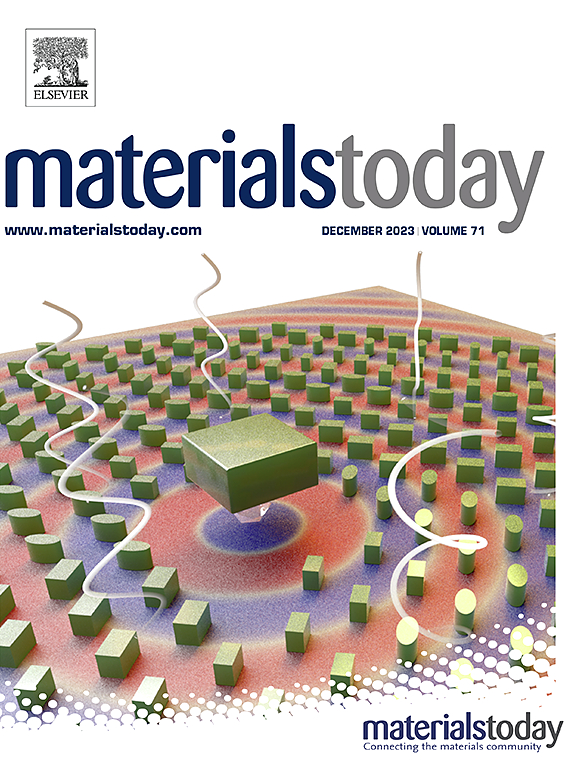Superacid assisted high-throughput production and solution-processing of pristine two-dimensional materials
IF 21.1
1区 材料科学
Q1 MATERIALS SCIENCE, MULTIDISCIPLINARY
引用次数: 0
Abstract
Pristine two-dimensional (2D) materials have a multitude of interesting properties, promising a broad spectrum of applications. However, their poor affinity for common solvents and tendency to aggregate impede their effective exfoliation and solution-processing into various structures, such as fibers and membranes, thus limiting their practical use. We report a high-efficiency method for producing pristine 2D nanosheets by direct high-speed shearing exfoliation in trifluoromethanesulfonic acid (TfOH). Typically, this method produces hexagonal boron nitride nanosheets (BNNSs) with an unprecedented throughput of 38.8 mg mL-1h−1. The effective exfoliation is attributed to the strong binding affinity, large dipole moment and steric repulsion of TfOH, which collectively introduce layer edge distortion in hexagonal boron nitride (hBN), facilitating its exfoliation. The mechanical exfoliation and reversible edge interaction introduce no additional functional groups to the exfoliated BNNSs. The resulting pristine BNNS exhibit remarkable stability in TfOH solutions at ultrahigh concentrations of 200 mg mL−1 for over 28 days. The viscosity of the highly concentrated BNNS/TfOH dispersion can be adjusted, enabling techniques to produce BNNS-based spheres, fibers, and membranes with high thermal conductivity and mechanical strength, suitable for advanced thermal management applications. Room temperature processed BNNS-based spheres exhibit superior thermal conductivity compared to high temperature processed commercially available hBN or Al2O3 spheres. Moreover, TfOH can also be used to assist the efficient production and solution-processing of other 2D nanosheets, including graphene, molybdenum disulfide and tungsten disulfide, enabling the fabrication of high-quality bulk assemblies.
超强酸辅助原始二维材料的高通量生产和溶液处理
原始二维(2D)材料具有许多有趣的特性,具有广泛的应用前景。然而,它们对普通溶剂的亲和力差,容易聚集,阻碍了它们的有效剥离和溶液加工成各种结构,如纤维和膜,从而限制了它们的实际应用。我们报道了一种在三氟甲烷磺酸(TfOH)中直接高速剪切剥离生产原始二维纳米片的高效方法。通常,这种方法生产六方氮化硼纳米片(BNNSs),其吞吐量达到38.8 mg mL-1h−1。六方氮化硼(hBN)具有较强的结合亲合力、较大的偶极矩和空间斥力,这些因素共同导致了层边畸变,促进了其剥离。机械剥落和可逆边缘相互作用没有给剥落的BNNSs引入额外的官能团。所得的原始BNNS在超高浓度(200mg mL−1)的TfOH溶液中表现出28天以上的显著稳定性。高浓度的BNNS/TfOH分散体的粘度可以调节,使技术能够生产具有高导热性和机械强度的BNNS基球,纤维和膜,适用于高级热管理应用。与高温加工的市产hBN或Al2O3球相比,室温加工的bnns球具有优越的导热性。此外,TfOH还可以用于辅助其他2D纳米片的高效生产和溶液加工,包括石墨烯,二硫化钼和二硫化钨,从而实现高质量的大块组件的制造。
本文章由计算机程序翻译,如有差异,请以英文原文为准。
求助全文
约1分钟内获得全文
求助全文
来源期刊

Materials Today
工程技术-材料科学:综合
CiteScore
36.30
自引率
1.20%
发文量
237
审稿时长
23 days
期刊介绍:
Materials Today is the leading journal in the Materials Today family, focusing on the latest and most impactful work in the materials science community. With a reputation for excellence in news and reviews, the journal has now expanded its coverage to include original research and aims to be at the forefront of the field.
We welcome comprehensive articles, short communications, and review articles from established leaders in the rapidly evolving fields of materials science and related disciplines. We strive to provide authors with rigorous peer review, fast publication, and maximum exposure for their work. While we only accept the most significant manuscripts, our speedy evaluation process ensures that there are no unnecessary publication delays.
 求助内容:
求助内容: 应助结果提醒方式:
应助结果提醒方式:


